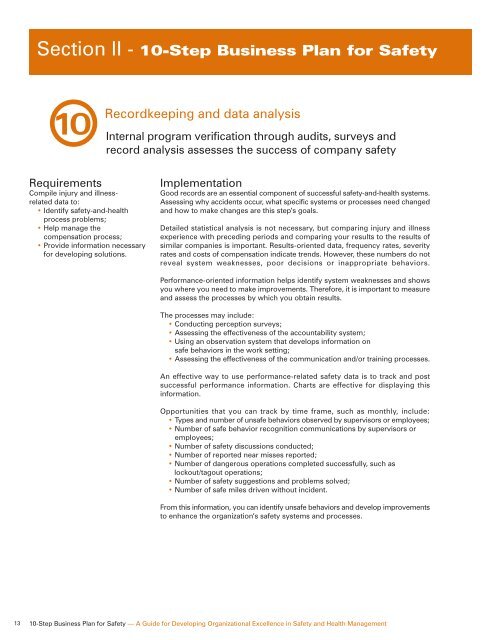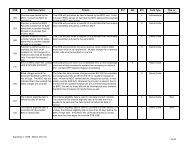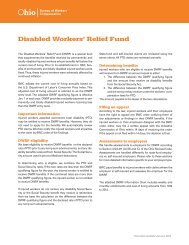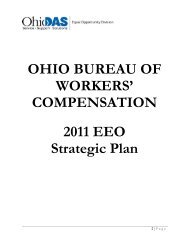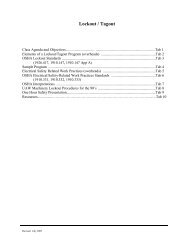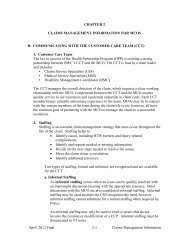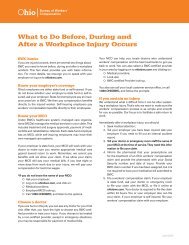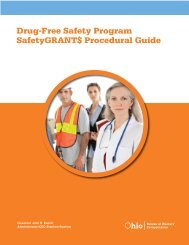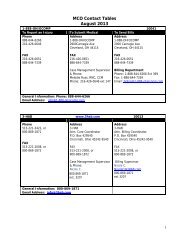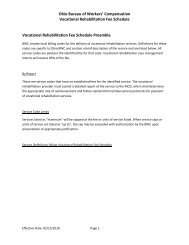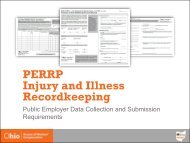BWC 10-Step Business Plan for Safety - Ohio Bureau of Workers ...
BWC 10-Step Business Plan for Safety - Ohio Bureau of Workers ...
BWC 10-Step Business Plan for Safety - Ohio Bureau of Workers ...
You also want an ePaper? Increase the reach of your titles
YUMPU automatically turns print PDFs into web optimized ePapers that Google loves.
Section II - <strong>10</strong>-<strong>Step</strong> <strong>Business</strong> <strong>Plan</strong> <strong>for</strong> <strong>Safety</strong><br />
<strong>10</strong><br />
Recordkeeping and data analysis<br />
Internal program verification through audits, surveys and<br />
record analysis assesses the success <strong>of</strong> company safety<br />
Requirements<br />
Compile injury and illnessrelated<br />
data to:<br />
• Identify safety-and-health<br />
process problems;<br />
• Help manage the<br />
compensation process;<br />
• Provide in<strong>for</strong>mation necessary<br />
<strong>for</strong> developing solutions.<br />
Implementation<br />
Good records are an essential component <strong>of</strong> successful safety-and-health systems.<br />
Assessing why accidents occur, what specific systems or processes need changed<br />
and how to make changes are this step’s goals.<br />
Detailed statistical analysis is not necessary, but comparing injury and illness<br />
experience with preceding periods and comparing your results to the results <strong>of</strong><br />
similar companies is important. Results-oriented data, frequency rates, severity<br />
rates and costs <strong>of</strong> compensation indicate trends. However, these numbers do not<br />
reveal system weaknesses, poor decisions or inappropriate behaviors.<br />
Per<strong>for</strong>mance-oriented in<strong>for</strong>mation helps identify system weaknesses and shows<br />
you where you need to make improvements. There<strong>for</strong>e, it is important to measure<br />
and assess the processes by which you obtain results.<br />
The processes may include:<br />
• Conducting perception surveys;<br />
• Assessing the effectiveness <strong>of</strong> the accountability system;<br />
• Using an observation system that develops in<strong>for</strong>mation on<br />
safe behaviors in the work setting;<br />
• Assessing the effectiveness <strong>of</strong> the communication and/or training processes.<br />
An effective way to use per<strong>for</strong>mance-related safety data is to track and post<br />
successful per<strong>for</strong>mance in<strong>for</strong>mation. Charts are effective <strong>for</strong> displaying this<br />
in<strong>for</strong>mation.<br />
Opportunities that you can track by time frame, such as monthly, include:<br />
• Types and number <strong>of</strong> unsafe behaviors observed by supervisors or employees;<br />
• Number <strong>of</strong> safe behavior recognition communications by supervisors or<br />
employees;<br />
• Number <strong>of</strong> safety discussions conducted;<br />
• Number <strong>of</strong> reported near misses reported;<br />
• Number <strong>of</strong> dangerous operations completed successfully, such as<br />
lockout/tagout operations;<br />
• Number <strong>of</strong> safety suggestions and problems solved;<br />
• Number <strong>of</strong> safe miles driven without incident.<br />
From this in<strong>for</strong>mation, you can identify unsafe behaviors and develop improvements<br />
to enhance the organization’s safety systems and processes.<br />
13<br />
<strong>10</strong>-<strong>Step</strong> <strong>Business</strong> <strong>Plan</strong> <strong>for</strong> <strong>Safety</strong> — A Guide <strong>for</strong> Developing Organizational Excellence in <strong>Safety</strong> and Health Management


